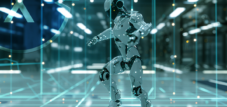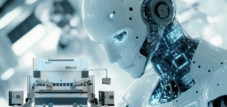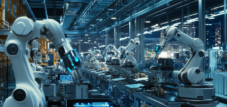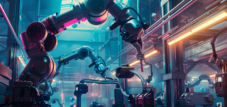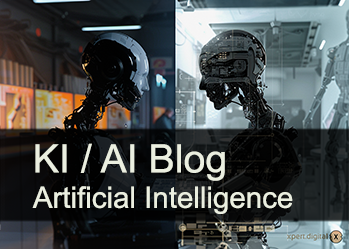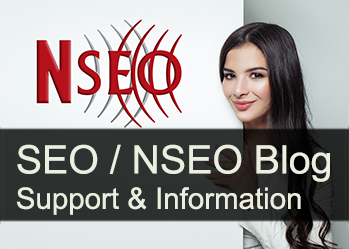Industry sensation: ABB sells robotics division to SoftBank for $5.4 billion – what's behind it
Language selection 📢
Published on: October 9, 2025 / Updated on: October 9, 2025 – Author: Konrad Wolfenstein

Industry sensation: ABB sells robotics division to SoftBank for $5.4 billion – what's behind it – Image: Xpert.Digital
After Kuka, now ABB: Europe's robot crown jewels continue to migrate to Asia
More than just robots: SoftBank's billion-dollar bet on the AI-driven future of automation
The Swiss electrical engineering group ABB is selling its robotics division to Japanese technology investor SoftBank for approximately $5.4 billion. This decision marks the departure of ABB from its previously announced plan to list the division as an independent company on the stock market in 2026. The deal is expected to close in mid- to late 2026 and is subject to regulatory approval. With the sale, one of Europe's major industrial robotics manufacturers will become an Asian company, following the acquisition of German robotics pioneer Kuka by the Chinese Midea Group in 2016.
Background: Who is ABB, what is its robotics division, and how does SoftBank fit into the picture?
Who is ABB and what role does the robotics division play within the company?
ABB is a global industrial group specializing in electrification, automation, and motion technology. The robotics division – ABB Robotics – comprises industrial robots, collaborative robots, integrated automation solutions, as well as software and services, particularly for industries such as automotive, electronics, logistics, food, and pharmaceuticals. In 2024, this division generated approximately $2.3 billion in revenue, accounting for approximately seven percent of Group revenue. The operating margin (EBITA) was 12.1 percent, significantly below the Group margin of 18.1 percent. ABB Robotics employs approximately 7,000 people and is one of the most established robotics providers with a global presence in Europe.
What distinguishes SoftBank as a buyer?
SoftBank is a Japanese technology investor known for its investments in telecommunications, internet platforms, semiconductors, and AI-related ecosystems. For years, SoftBank has pursued a strategy of investing in scalable future technologies – from mobile communications and cloud infrastructure to AI models and hardware-related platforms. The acquisition of an established robotics division like ABB's fits into a vision of merging robotics-related value creation with AI-supported automation, thereby developing data-driven platform effects and service revenues.
Why is the comparison with Kuka-Midea from 2016 relevant?
Midea's acquisition of Kuka was a milestone demonstrating the shift of European robotics core competencies to Asian ownership. The ABB-SoftBank deal continues this trend: the second major European industrial robotics provider has now also found an Asian owner. This is remarkable from an industrial policy perspective, as robotics technology is considered a key field for industrial value creation, the digitalization of production, and the strategic resilience of economies.
Strategic motives: Why is ABB selling and why is SoftBank buying?
What are ABB's strategic reasons for selling instead of going public?
From ABB's perspective, there are several plausible motives. First, the sale provides immediate access to value for shareholders, unlike an IPO, whose valuation and timing depend on the capital market environment. Second, the robotics margin of 12.1 percent was significantly below the Group margin of 18.1 percent, which depressed overall profitability. Third, robotics is capital-intensive and cyclical: scaling, R&D in AI-assisted vision, software, sensors, and global market penetration require significant investments. The spin-off reduces complexity, focuses ABB on high-margin segments such as electrification and process automation, and strengthens the balance sheet. Fourth, an industrially experienced owner can develop robotics more specifically, for example, through ecosystem partnerships, platform strategies, and targeted acquisitions.
What are SoftBank's motives for the purchase?
SoftBank could pursue several strategic objectives. First, the combination of industrial robotics with AI software, cloud platforms, and data services to increase recurring revenue. Second, the expansion of a robotics ecosystem with access to manufacturing, logistics, and service industries that are rapidly automating. Third, the opportunity to increase market penetration through economies of scale in Asia, especially Japan, Korea, and China. Fourth, the integration into portfolio companies that benefit from robotics, such as e-commerce logistics, electronics manufacturing, semiconductor backend, and healthcare. Fifth, the option to finance the necessary development cycles through longer-term investment horizons and flexibility beyond quarterly reporting requirements.
Valuation and price: Is the deal “fair” and how does it rank?
What does the purchase price of $5.4 billion say about the valuation?
The purchase price reflects the revenue and margin of ABB's robotics division. With revenue of $2.3 billion, the price would correspond to approximately a 2.35x revenue multiple. In robotics, revenue multiples are widely diversified and depend heavily on growth, software share, service revenue, and market position. A multiple of this magnitude signals solid appreciation for an established, global provider with a proven product portfolio, but without the premium valuation of typical software companies. Given an EBITA margin of 12.1 percent, the price appears to reflect SoftBank's significant upside from margin-enhancing measures, scaling, and software servitization. For ABB itself, the price is attractive enough to disincentivize an IPO, especially since an IPO in a volatile market environment carries valuation risks.
How does the deal compare to the 2016 Kuka takeover?
Kuka was acquired by Midea in 2016 for just over four billion euros, at the time enjoying a strong position in automotive automation and a high brand value in Europe. The ABB-SoftBank deal is nominally larger, which is explained both by the size of the entity and by market developments over the past decade. The decisive factor is less the absolute price than the strategic landscape: Both transactions shift European robotics expertise to Asian ownership models, which shapes global competition and Europe's industrial sovereignty.
Market environment: Why now and how is the robotics market developing?
What trends are driving the current robotics boom?
Several macro and technology trends are reinforcing each other. First, there is the labor shortage in industrial and logistics professions, exacerbated by demographic change. Second, there is reshoring and nearshoring, which shift production capacity back to high-wage regions and thus require automation to contain costs. Third, there is productivity pressure due to volatile demand, supply chain risks, and intense competition. Fourth, there are technological leaps in AI, particularly in perception (computer vision), grasping and manipulation, path planning, simulation, and foundation models for robotics, which increase adaptability and autonomy. Fifth, there is the growing penetration of collaborative robots (cobots), mobile robotics (AMR/AGV), and software-defined automation in brownfield environments. These factors together are increasing the willingness to invest in robotics, even beyond the automotive industry.
What role do software and AI play in the next phase of robotics growth?
Software is becoming the central value driver. AI-supported perception, generative simulation environments, data pipelines from sensors to the cloud, and modular orchestration of multiple robot types lead to higher OEE, faster deployments, and lower integration costs. In addition, no- and low-code programming environments are alleviating the skills shortage for PLC and robotics specialists. The share of recurring revenue from software licensing, updates, cloud services, predictive maintenance, and digital twins is expected to increase. Owners with tech DNA, such as SoftBank, can invest specifically in these modules and leverage portfolio synergies.
How does the automotive sector compare to other industries?
The automotive industry remains a core customer, but electronics manufacturing, battery and cell production, logistics and fulfillment centers, food processing, pharmaceuticals, and medical technology have caught up. This diversification stabilizes demand and favors modular platforms that serve multiple use cases. Especially in e-commerce logistics and electronics manufacturing, the need for variable-capable robotic solutions with sensitive handling, visual recognition, rapid product changeovers, and close human-robot collaboration is increasing.
Impact on ABB: What does the sale mean for the company?
How does the sale change ABB's strategic direction?
Following the sale, ABB can focus more strongly on segments with above-average profitability and clear synergies, such as electrification solutions, motion technology, process automation, and energy management. These areas benefit from megatrends such as the energy transition, grid modernization, Industry 4.0, electromobility, and data center infrastructure. The proceeds from the sale will strengthen the balance sheet and enable capital discipline, for example through targeted acquisitions in core segments, debt reduction, or capital repayments. The management focus is also important: reduced complexity, clearer priorities, and a sharper portfolio story for investors.
Could ABB be disadvantaged later by the loss of the robotics division?
Giving up its own vertically integrated robotics expertise can limit strategic options, especially for complete end-to-end automation offerings. Nevertheless, ABB can continue to deliver powerful automation solutions through partnerships, ecosystems, and open interfaces. Furthermore, the exit reduces exposure to cycles typical of robotics and shifts investment risks to an owner who wants to manage them more effectively. The trade-off is between focus and vertical depth; ABB opts for focus and capital-efficient value creation.
Impact on SoftBank: What could SoftBank do with ABB Robotics?
What synergies are realistic for SoftBank?
SoftBank can leverage several levers. First, scaling in core Asian markets, particularly in Japan and East Asia, where robotics is closely located to manufacturing clusters. Second, integrating AI stacks for perception, control, and optimization, which increase productivity and margins. Third, expanding recurring software and service revenues. Fourth, targeted acquisitions in niches such as gripper technology, 3D vision, mobile robotics, or industry software. Fifth, leveraging existing customer relationships within the SoftBank network, including telecom, data center, logistics startups, and platform companies.
What risks does SoftBank need to consider?
Robotics is capital- and development-intensive, with long implementation cycles and integration-heavy projects. Competition from global heavyweights and agile specialists is intense. Margins and cash flow depend heavily on the project mix and service share. Acquisitions carry integration risks. Furthermore, regulatory requirements are demanding: safety, functional safety, CE and ISO standards, cybersecurity of things, and industry-specific regulations. Success lies in combining industrialization, software expertise, and go-to-market excellence.
Regulation and closing: What hurdles need to be overcome by 2026?
What permits are still pending?
The deal requires approval from antitrust and competition authorities in several jurisdictions. Depending on the production and sales markets, European, US, and Asian authorities may be involved, among others. In addition, reviews may be required regarding export controls, technology transfer, investment reviews, and national security concerns. The complexity is less than for acquisitions involving critical infrastructure, but robotics, as a key technology, is not immune to risks. The targeted completion in mid- to late 2026 appears realistic, but leaves room for delays if conditions are imposed.
Can we expect political debates in Europe?
Yes, the deal is likely to trigger debates about European technological sovereignty, core industrial competencies, and the protection of strategic assets. Following the Kuka takeover, there were already discussions about investment controls. However, national positions and economic policy priorities differ. Since ABB is a Swiss corporation and its robotics division operates globally, the political sensitivity may be less than for purely nationally anchored companies, but it remains an issue for associations and politicians.
Industrial perspective: What does the change of ownership mean for customers, competitors, and partners?
How will industrial customers react to the change of ownership?
Many industrial customers primarily value product quality, delivery capability, service coverage, and roadmap reliability. A strong owner can inspire trust by increasing investment and innovation capacity. Continuity in production, supply chains, spare parts service, and software support will be crucial. If SoftBank accelerates its focus on software, AI, and digital services, this could increase customer value, provided compatibility and integration efforts are considered. In the short term, stability in ongoing projects and the service organization is essential.
How do competitors position themselves in this environment?
Competitors will use the transition phase to strengthen customer loyalty, increase SLAs, and aggressively communicate their technology roadmaps. In segments such as cobots, mobile robotics, vision, and gripping technology, competitors will specifically target those willing to switch, especially for high-volume, standardizable applications. In highly specialized line projects, willingness to switch will remain low due to high integration costs. Suppliers with strong software stacks and turnkey solution modules will attempt to position themselves as lower-risk alternatives.
What opportunities arise for integrators and ecosystem partners?
System integrators, machine builders, and software partners can benefit if SoftBank prioritizes the expansion of partner programs, SDKs, APIs, and simulation environments. Open interfaces and certified app ecosystems accelerate time to value. New service offerings such as pay-per-use, robotics-as-a-service, or performance-based contracts could complement traditional capex projects and integrate integrators into recurring revenue models. At the same time, the need for cybersecurity, compliance documentation, and safety engineering is growing—an opportunity for specialized service providers.
Technological roadmap: What can we expect from product and technology development?
What technological focuses are likely?
The following key areas are obvious: First, advanced perception systems with multimodal sensor fusion (vision, depth, force/torque, tactile sensors) and self-calibrating pipelines. Second, advanced grasping and manipulation capabilities with adaptive grippers and learning from demonstration. Third, generative simulation and digital twins for rapid commissioning, validation, and continuous optimization. Fourth, AI-supported scheduling that delivers robust performance in variable environments. Fifth, open software platforms that integrate third-party manufacturers and enable lifecycle services. Sixth, safety and cybersecurity by design to increase compliance and resilience in the field.
What role do collaborative robots and mobile platforms play?
Collaborative robots will continue to infiltrate manual workplaces where flexibility, small footprint, and rapid changeover are essential. Mobile robotics enables dynamic material flows orchestrated by WMS/MES/ERP. The combination of cobots and AMR opens up versatile applications, such as flexible assembly islands, significant cycle time gains in intralogistics, and last-mile material supply in brownfield sites. The key lies in robust navigation, safety, and fleet management stacks, as well as seamless integration into existing production IT.
Is software-defined automation becoming the new norm?
Yes, the trend toward software-defined automation is increasing. Abstraction layers above the physical hardware enable processes to be modeled, orchestrated, and modified more quickly. This reduces dependence on proprietary controllers and promotes interoperability. In this context, robotics-agnostic programming environments, modular skills libraries, standardized interfaces, and digital twins would be key building blocks. Owners with strong software and platform expertise can build structural advantages here.
Financial implications: What does the EBITA difference mean and how can value be leveraged?
Why is the EBITA margin of the robotics division lower than the group margin?
Robotics combines hardware, integration, service, and increasingly software. Especially in the project business, margins are naturally lower than in standardized product lines due to customer-specific adaptations, commissioning, and warranties. Furthermore, R&D expenditures in AI, sensors, and software require continuous investment. Competition with price pressure in standard robots squeezes gross margins, which is why differentiation through software and services is essential. ABB's corporate mix includes higher-margin segments that increase the overall margin and explain the difference to the robotics division.
How could SoftBank increase margins?
Three approaches are key. First, a mix shift toward software, services, and licenses—with upgrades, fleet management, predictive maintenance, and AI modules. Second, economies of scale in manufacturing and the supply chain, including design-to-cost, global sourcing, and platform standardization. Third, focused sales and integration strategies that increase the proportion of repeatable, blueprint-capable solutions and reduce project variants. In addition, partnerships and vertical bundling in growth industries can improve price realization.
Economic and geopolitical classification: What is changing in the global power field?
What significance does the deal have for Europe's industrial sovereignty?
The deal underscores that Asian ownership structures are gaining influence in key technologies such as robotics. For Europe, the question is less whether the source of capital is "right" or "wrong," but rather how to make technology and value chains resilient. Manufacturing expertise, R&D locations, standards, and the ability to maintain and expand ecosystems in Europe are crucial. At the same time, a smart industrial policy is needed that promotes investment in automation, semiconductors, cloud/edge, and software and attracts talent. Changes in ownership need not necessarily be a disadvantage, as long as location decisions, employment, and R&D are maintained or expanded within the region.
Will the deal lead to more M&A activity in robotics?
Probably yes. Larger players will acquire niche competencies to complete their portfolios, and financial investors see growing, fragmented markets with room for consolidation. At the same time, startups are emerging that are building AI-native robotics stacks. The tension between consolidation and innovation will shape the coming years. Strategists with clear platform logic and integration expertise will have an advantage.
Our global industry and economic expertise in business development, sales and marketing

Our global industry and business expertise in business development, sales and marketing - Image: Xpert.Digital
Industry focus: B2B, digitalization (from AI to XR), mechanical engineering, logistics, renewable energies and industry
More about it here:
A topic hub with insights and expertise:
- Knowledge platform on the global and regional economy, innovation and industry-specific trends
- Collection of analyses, impulses and background information from our focus areas
- A place for expertise and information on current developments in business and technology
- Topic hub for companies that want to learn about markets, digitalization and industry innovations
Software-First Robotics: AI as a Competitive Factor
Impact on labor markets and skills: What does the change mean for employees?
What consequences will the change of ownership have for the robotics division's workforce?
In the short term, continuity and predictability are important: product roadmaps, service contracts, and global supply chains must remain stable. In the medium to long term, new career paths may open up, particularly in software, AI, data products, cybersecurity, and digital services. At the same time, traditional skills in mechanics, electrical engineering, and control engineering will remain indispensable, but will increasingly merge with software and data capabilities. Continuing education programs and internal mobility will become critical to success in preparing the workforce for the next phase of growth.
Will robotics replace or transform jobs?
Robotics will primarily transform jobs. Physically demanding, repetitive, and dangerous tasks will be disproportionately automated. At the same time, new roles will emerge in planning, integration, operations, maintenance, and data analysis. In mature markets with labor shortages, robotics will increasingly serve to maintain production capacity and quality, rather than simply as a substitute. Productivity gains can be reflected in higher wages for skilled workers and in competitive production, provided training and transformation are actively managed.
Customer benefits and business models: How is the value proposition changing?
What benefits do end customers expect from the new ownership structure?
End customers could benefit from accelerated innovation and a stronger software focus. More quickly available AI functionalities, robust simulation, more efficient commissioning, and improved service levels are possible outcomes. Further potential lies in flexible procurement and operating models, such as subscriptions, user fees, or performance contracts, which can lower capex hurdles and shorten time to value. It is important that product roadmaps remain transparent and migration paths are reliable for existing customers.
What role do open ecosystems and standardization play?
Open ecosystems are a catalyst for speed and diversity. Standardized interfaces, interoperable stacks, and certified modules facilitate integration projects, reduce risks, and promote third-party innovation. For the new owner, this presents an opportunity to build developer communities and partner networks that make the platform attractive. At the same time, standardization is never an end in itself: it must strike a balance between stability and the speed of innovation.
Risks and uncertainties: What can go wrong?
What are the main risks associated with the deal until closing?
Three levels of risk must be considered. First, regulatory risks: Approval procedures can be delayed or impose additional requirements. Second, operational risks: Carve-out complexity, IT and process separation, supplier and customer contracts, and personnel transitions must be carefully managed. Third, market and technology risks: Economic weakness, investment reluctance in key industries, or technological disruption by new competitors could impact performance. Transparent communication with stakeholders and a robust transition plan are therefore crucial.
How might exchange rates, interest rates, and capital market conditions affect the transaction?
Exchange rate fluctuations can put the purchase price expressed in US dollars into perspective. Interest rate levels influence both financing costs and valuation multiples in the sector. An unfavorable capital market environment could have burdened a potential IPO and, in retrospect, strengthens the logic of a trade sale. For the buyer, interest rates influence the opportunity cost of capital and return expectations. Hedging strategies and flexible financing instruments are common responses to these volatility fluctuations.
Parallels and differences to previous transactions: What is different this time?
In what ways is the ABB-SoftBank deal similar to previous robotics acquisitions?
The logic of M&A-driven portfolio focus for the seller and platform expansion for the buyer is familiar. The shift of European robotics assets to Asian ownership also continues a trend. The focus on synergies in software, AI, and services is reminiscent of the increasing "servitization" of industrial hardware.
What makes this deal different from previous ones?
What's striking is the clear departure from the previously outlined IPO in favor of immediate access to value with predictable transaction security. Furthermore, the framework conditions fall into a phase of accelerated AI development, in which robotics stacks are changing rapidly. The change of ownership to a technology-savvy investor increases the likelihood that the division will continue to develop consistently toward software-defined, AI-centric robotics. Finally, the global discussion about resilience, supply chains, and industrial policy is much more present than in 2016 – which puts regulation and strategic location decisions more into focus.
Roadmap to 2026: Which milestones are relevant?
What steps can be expected until the expected closing in mid/late 2026?
First, the application must be submitted to competition and investment control authorities. At the same time, management is working on carve-out structures: legal entities, IT systems, brand and IP assignments, supplier and customer contracts, and HR processes. A Transitional Services Agreement (TSA) between ABB and the new entity is likely to secure the operational transition. Communication milestones include product roadmaps, service commitments, partner programs, and migration paths. Internal programs for employee retention and talent acquisition are also crucial. Strategic acquisitions can be prepared before closing, but are typically only completed after approval.
What should customers and partners do in this phase?
Customers should review existing contracts and SLAs, request roadmap workshops, and document compatibility commitments. Partners and integrators should seek early coordination with the new ownership structure regarding certifications, interfaces, and support channels. Pilot projects for software modules, simulation, and asset management can help translate the transition into productive benefits. At the same time, risk management for critical spare parts and training programs for personnel are recommended.
Practical perspective: What does this mean specifically for typical application areas?
How does the deal affect automobile and battery production?
In automotive assembly and body construction, reliability, cycle time, and quality are key. For these applications, continuity in controllers, tooling, and safety is essential. In battery and cell production, a rapidly growing field, competitiveness depends on high-precision handling and joining processes, as well as cleanroom requirements. A SoftBank-driven roadmap could, in particular, prioritize software optimization, inline quality control, AI vision, and digital twins to increase yield and availability. Customers will expect stability but welcome innovation if it delivers measurable OEE gains.
What changes for electronics manufacturing and semiconductor backend?
These segments demand high flexibility with small batch sizes and short product life cycles. Robotics must work closely with Manufacturing Execution Systems and AOI/AXI inspections. AI-supported gripping strategies, adaptive force control, and rapid reconfiguration are key. An accelerated software agenda can improve throughput and first-pass yield, while modular cells reduce investment risks. For semiconductor backends and test environments, cleanliness, precision, and traceability are top priorities—areas where standardized, validated software stacks make the difference.
What effects can be expected in logistics and fulfillment?
In logistics centers and e-commerce fulfillment, the focus is on AMR fleets, pick-and-place cells, mixed-SKU handling, and sorting. AI-supported gripping and recognition capabilities, as well as fleet coordination, determine productivity. Pay-per-use models, rapid rollouts, and fleet analytics are particularly attractive. A technology-oriented owner could push a strong platform strategy with APIs to WMS/TMS and build ecosystems of application partners.
What is the situation in the food and pharmaceutical industries?
Requirements for hygiene, traceability, validation, and compliance dominate here. Robotics must combine robust, easy-to-clean hardware with validated software modules. Predictive maintenance, software-based recipe changes, and comprehensive documentation are key success factors. A stronger focus on industry-specific software modules can shorten implementation times and simplify audits.
Technological competitive dynamics: Who sets the standards and where are the paths for differentiation?
Where can robotics providers differentiate themselves in the future?
Three differentiation paths are emerging. First, AI excellence in perception, planning, and control, coupled with high-quality simulation and digital twin environments. Second, depth of integration and time to value: preconfigured, scalable cells and software building blocks that quickly become productive in brownfield environments. Third, ecosystem attractiveness: app-like extensions, developer support, clear SDKs, and marketplace models. In addition, safety and cybersecurity competencies are becoming hygiene factors, while lifecycle services shape customer loyalty.
What role does hardware innovation still play?
Hardware remains important, especially in terms of precision, reliability, ease of maintenance, and total cost of ownership. At the same time, the core of differentiation is shifting toward software. Hardware innovations—lighter joints, energy-efficient drives, integrated sensors—remain relevant, but are difficult to monetize without powerful software stacks. The future belongs to "hardware plus software plus service" as an integrated value proposition.
Governance and organization: How should the new unit be set up?
Which organizational principles are crucial for success?
A product-centric organization with clearly defined platform teams for core hardware, control, perception, simulation, and the ecosystem is a good fit. Strong product management expertise that links customer segments with clear use case roadmaps is essential. Go-to-market should be vertically aligned to precisely reflect industry requirements. Global supply chain and quality management with end-to-end responsibility ensures resilience. A security office that integrates safety, cybersecurity, and compliance is also required. Talent strategies and partnerships with universities and R&D clusters strengthen the innovation pipeline.
Which KPI logic supports value creation?
In addition to traditional financial KPIs such as revenue growth, gross margin, and EBITA, the following metrics are central: software and service share of revenue, recurring revenue, attach rates for digital modules, time to deployment, customer OEE improvements, NPS/CSAT in service, mean time to repair, first-time fix rate, security and compliance metrics, as well as delivery capability and on-time delivery. Relevant for platform economics are active developers, the number of certified partner solutions, and ecosystem revenue.
Investor perspective: How should the deal be assessed by different types of investors?
What does the sale mean for ABB shareholders?
For ABB shareholders, the deal creates immediate access to value instead of an uncertain IPO path. The sale price reflects the strength of the robotics division and reduces the margin gap within the group. The net effect depends on the use of the funds: debt reduction strengthens the balance sheet, share buybacks or special dividends can directly increase returns, and strategic acquisitions can boost future profitability. The trade-off between foregoing the option to participate in a standalone robotics story is the downside of the deal – but it increases the clarity of ABB's portfolio narrative.
How should private equity and venture investors read the market?
Private equity is likely to see increased consolidation opportunities, particularly in niches such as vision, grippers, software orchestration, and industry-specific applications. Venture investors are finding opportunities in AI-native robotics, simulation, foundation models for robotics, and modular automation cells. At the same time, the market requires patience, as industrialization, certification, and scaling require time and capital. Teams that combine domain expertise with modern AI software are critical to success.
Long-term scenarios: What might the market look like in five to ten years?
Which development scenarios are plausible?
Three scenarios are conceivable. First, "software-first robotics": Providers with strong AI stacks dominate, hardware is modularized, platform economies emerge, and recurring revenues dominate the industry. Second, "integrated industrial giants": A few corporations control end-to-end stacks from sensors and robots to cloud and services, with tight vertical integration. Third, "ecosystem diversity": Open standards enable competition at the module level, and many specialists cooperate via marketplaces. A hybrid world is realistic, in which different models dominate depending on the industry.
What role do regulation and standards play?
Regulations regarding security, AI transparency, data usage, and cybersecurity are becoming more influential. Those who embrace compliance by design early on gain momentum in regulated industries. Standards for interoperability and interfaces are catalysts for ecosystems. Standardization efforts and open source components in non-security-critical layers can accelerate development.
What is the central message of this deal?
What can be said as a key conclusion?
The sale of ABB's robotics division to SoftBank marks a turning point in the European robotics landscape. A large, long-established provider is transferring to Asian ownership, while ABB focuses on more profitable core businesses and delivers immediate value to shareholders. SoftBank is gaining a strong industrial asset with a global footprint and significant upside from software, AI, and services. Customers value stability and accelerated innovation, while the industry is accelerating the merging of hardware, software, and data-driven business models. Until the planned closing in 2026, regulation and carve-out execution remain the key hurdles; afterward, the ability to combine platform logic, ecosystems, and industrial excellence will be decisive.
Frequently asked questions and concise answers
How big is ABB's robotics division in numbers?
Approximately 7,000 employees, USD 2.3 billion in revenue in 2024, a roughly seven percent share of ABB's Group revenue, and an EBITA margin of 12.1 percent. This is below the group average of 18.1 percent and helps explain why the division appears less attractive than other segments within the company's logic.
When is the deal expected to close?
Completion is scheduled for mid- to late 2026, subject to regulatory approval. This period allows for regulatory review and the complex operational spin-off.
Why did ABB abandon its IPO plan?
The sale offers immediate value and transaction certainty compared to an IPO, which is dependent on market volatility, interest rates, and valuation uncertainties. Added to this is the prospect that a technology-oriented buyer can develop the division more selectively than would be possible under the umbrella of a diversified industrial group.
What does the deal mean for European robotics?
Europe remains technologically strong, but is once again losing ownership of a top asset to Asian investors. This increases the pressure to invest in R&D, talent, standards, and ecosystems to secure value creation in Europe. Ownership and location are not identical – what is important is that European capacities are retained and expanded.
What should existing customers do now?
Intensify dialogue with the vendor, establish roadmaps and migration paths in writing, review service and spare parts agreements, test potential upgrades in simulation and software, and implement controlled risk management for critical assets. At the same time, examine opportunities for productivity gains through new AI modules.
What opportunities does SoftBank ownership offer?
Greater investment power in AI software, platform and service development, scaling in Asia, potential partnerships within the SoftBank network, and a long-term investment horizon. If successful, margins can rise and the speed of innovation can accelerate.
Which risks need to be considered in particular?
Regulatory approvals, carve-out complexity, potential market cyclicality in investment-intensive industries, integration risks in acquisitions, and the pressure to attract and retain sufficient software talent are key factors for success.
How does the deal affect the competitive structure?
In the short term, competitors can expect uncertainty; in the medium to long term, everything depends on how consistently the new entity implements its platform and software strategy. A strong, software-centric robotics provider can reshape markets—especially in cross-segment applications where time to value and interoperability are key.
Will the deal accelerate or slow down innovation?
If executed successfully, acceleration is likely, as focused governance, greater risk tolerance for software development, and a clear platform logic allow for faster iterations. Delays are likely if carve-out, compliance, and integration of technology components are underestimated.
What role will partner ecosystems play in the future?
A key one. The future of robotics lies in scalable, interoperable building blocks. An active partner ecosystem with certified solutions, clear APIs, and developer support will help determine market dynamics and the speed of innovation. Suppliers who open platforms to third parties create network effects and increase customer loyalty throughout the entire system lifecycle.
Your global marketing and business development partner
☑️ Our business language is English or German
☑️ NEW: Correspondence in your national language!
I would be happy to serve you and my team as a personal advisor.
You can contact me by filling out the contact form or simply call me on +49 89 89 674 804 (Munich) . My email address is: wolfenstein ∂ xpert.digital
I'm looking forward to our joint project.
☑️ SME support in strategy, consulting, planning and implementation
☑️ Creation or realignment of the digital strategy and digitalization
☑️ Expansion and optimization of international sales processes
☑️ Global & Digital B2B trading platforms
☑️ Pioneer Business Development / Marketing / PR / Trade Fairs
B2B support and SaaS for SEO and GEO (AI search) combined: The all-in-one solution for B2B companies

B2B support and SaaS for SEO and GEO (AI search) combined: The all-in-one solution for B2B companies - Image: Xpert.Digital
AI search changes everything: How this SaaS solution is revolutionizing your B2B rankings forever.
The digital landscape for B2B companies is undergoing rapid change. Driven by artificial intelligence, the rules of online visibility are being rewritten. It has always been a challenge for companies to not only be visible in the digital masses, but also to be relevant to the right decision-makers. Traditional SEO strategies and local presence management (geomarketing) are complex, time-consuming, and often a battle against constantly changing algorithms and intense competition.
But what if there were a solution that not only simplifies this process, but makes it smarter, more predictive, and far more effective? This is where the combination of specialized B2B support with a powerful SaaS (Software as a Service) platform, specifically designed for the needs of SEO and GEO in the age of AI search, comes into play.
This new generation of tools no longer relies solely on manual keyword analysis and backlink strategies. Instead, it leverages artificial intelligence to more precisely understand search intent, automatically optimize local ranking factors, and conduct real-time competitive analysis. The result is a proactive, data-driven strategy that gives B2B companies a decisive advantage: They are not only found, but perceived as the authoritative authority in their niche and location.
Here's the symbiosis of B2B support and AI-powered SaaS technology that is transforming SEO and GEO marketing and how your company can benefit from it to grow sustainably in the digital space.
More about it here:








